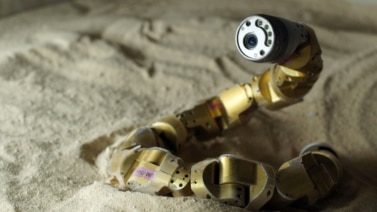Many teachers believe that “hands-on” experience is the best way to learn. A group of students in the United States is putting that belief to the test.
The students are with the Stevens Institute of Technology in Hoboken, New Jersey. They successfully designed and built a robot for uncovering unexploded mines at the bottom of the sea. The technology students made the robot to answer a challenge from the U.S. Department of Defense.
The underwater vehicle is called Perseus II. The students recently tested Perseus II in a 95-meter-long tank of water at the Stevens Institute of Technology.
The robot costs about $15,000 to build. The students use a video game controller to direct its movements at the bottom of the tank. Devices known as thrusters enable the robot to go up, down, and toward its target in the water.
Video cameras on the robot send images back to a computer through a 13-meter long cable. Perseus II also has a set of lasers. They are used to measure the size of an object.
The robot is the creation of five undergraduate students. For over six months, they worked between 15 and 20 hours a week to design and build Perseus II.
Michael DeLorne supervised the project. He says the specialized requirements of the robot were demanding.
“Their goal was to go down and find this unexploded ordnance and not only just find them but provide information to an expert on the surface so he or she could make a decision whether it was something dangerous or not.”
Michael DeLorne says the students came up with some resourceful solutions for difficult problems. One such problem was how to control the position of the robot while underwater.
"One unique thing they did, they developed an algorithm that allowed them to autonomously control the vehicle's depth.”
Mark Siembab is a member of the Perseus II team. He says the team developed a low-cost method to mark the location of whatever object they found.
“One component sank to the bottom and anchored itself while the other component had a brightly colored orange ball, which would float to the surface and provide a positive identification to the passer-by or the authorities to let them know there's an object down there and we'd marked it.”
Perseus II was successfully tested in Florida with similar robots built at other engineering schools. In a separate development, new students at the Stevens Institute of Technology have already started on the next project. It is an unmanned flying vehicle they are calling Perseus III.
I’m Jonathan Evans.
This report was based on a story from VOA’s George Putic in Hoboken, New Jersey. Jonathan Evans wrote it for VOA Learning English. George Grow was the editor.
Words in this Story
autonomously – adv. existing or acting separately from other things or people
challenge – n. a difficult task or problem; something that is hard to do
hands-on – adj. gained by actually doing something rather than learning about it from books, lectures, etc.
mine – n. a bomb that is placed in the ground or in water and that explodes when it is touched
Now it’s your turn to use these Words in This Story. In the comments section, write a sentence using one of these words and we will provide feedback on your use of vocabulary and grammar.

